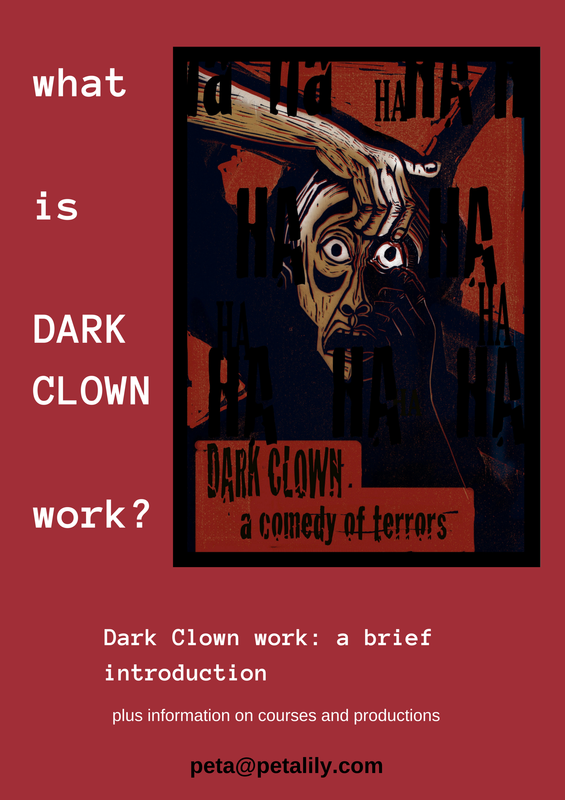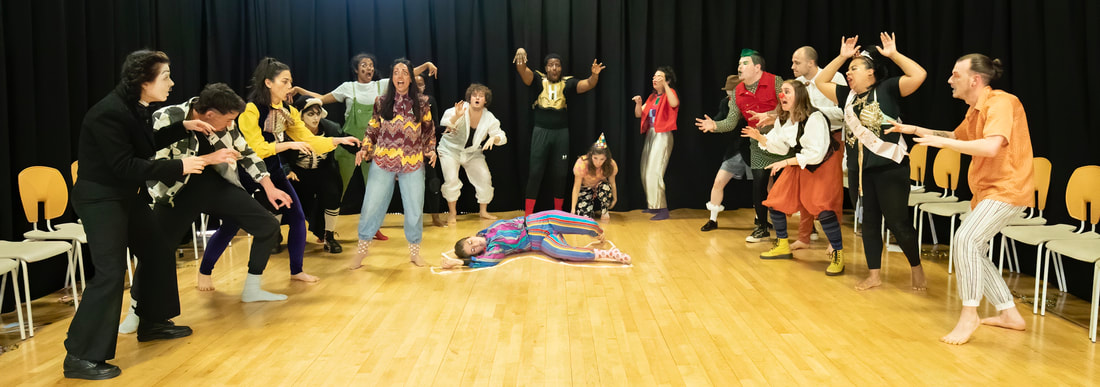 Photo: Linda Carter
Photo: Linda Carter Comedy and Tragedy
Tragedies are perfect to adapt for Clown – the contrast between the high and the low, the lofty and the stupid is so sweet. If you’re a fan of this blog, you’ll have read other Clown Dramaturgy posts. This year, we approached Shakespeare’s mighty tragedy Hamlet.
Hamlet is ‘clown ready’ - it’s a great big tragedy full of failure, clumsiness and lack of nobility: ‘I’ll lug the guts into the neighbor room’.
Content warning – the tragic events of Hamlet: war, death etc - are mentioned in this post.
This blog post reflects on Clown Dramaturgy in the Spring 2023 production on the MA Theatre Lab at RADA, where a clown troupe play a classic text. It is devised and rehearsed in just 10 hours. A sharing/showing with no technical aspects.
Clown Council Process – to find key ideas and help casting
The Clown Council is an effective clown devising tool. It’s described in this blog post and mentioned in this one also.
The Clown Council not only brings out the themes the group are interested in, but the proclivities of individuals in the group; which makes it useful as a casting process.
With the group of 18 assembled in a seated circle, one clown stood and weighed her hands on either side and said ‘It’s all - should I do this, should I do that?’, conveying her exasperation with Hamlet’s inaction and equivocation. Another stood and raised a mime sword and said in a sweet high-pitched voice, ‘Conflict’ - the gesture was so innocently valiant. One of them mimed digging a grave. ‘Madness!’, said another. ‘Slutty mother’, said another clown. Another laments Ophelia as a victim of patriarchy: ‘Hashtag MeToo!’.
Key idea
We all liked the idea of Hamlet being therapized. One student suggested the show title ‘Fixing Hamlet’. Brilliant – the clowns have a mission and therefore the show has the possibility to be a machine for failure. Comedy (like Drama) is about things going wrong.
In our next session, I divided the group in two and asked each to construct an image of a therapist’s couch, using their bodies. We chose one version and detailed it. Then the second group made a throne-like therapist’s chair.
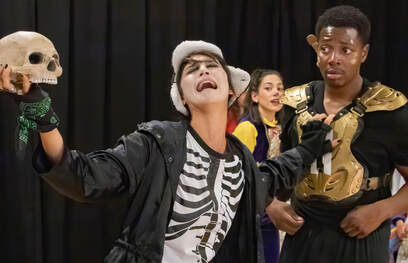
Self-casting
The Clown that had gestured with her hands became our Hamlet, lying down for a therapeutic session on a couch made of beleaguered fellow clowns.
The clown who had called out ‘Madness’ became the therapist. The ‘slutty mother’ clown was delighted to play Gertrude.
A trip to the props store yielded a small golden breastplate for the valiant clown and an assortment of swords, including a small, wooden sword. We didn’t at first know who this character would be. We began sketching out a couple of scenes - and in one moment it was clear: ‘You’re Horatio!’. He grabbed some masking tape and made a superhero-style H on his armour. Poor helpless Horatio, always at the ready to serve and support his friend and only rewarded by always having to helplessly watch.
Engagement and the Game (with the audience)
But why have the clowns gathered and what for? To further clarify our adaptation and to further engage, we discussed what the game with the audience might be.
The idea of Hamlet as a problematic, self-involved, dithering figure led to the idea of an Intervention. But not for Hamlet, for the audience. A Google search led to an article saying that part of the intervention process is the reading of a letter – handy template was provided, and adapted.
Intervention Clown: reading letter: “Dear Audience,
We love you … but not in a creepy way.
You may not think about us much, but we think about you … but not in a creepy way.
You have watched us, but we have also
watched you. Watched you as you sat in front of the theatre stage and cried.
We know that your lives are busy and that once the comedy and tragedy are over, you pack away your tissues and armour up your hearts.
knock knock (one clown knocks on Horatio’s breastplate.)
Because the life out there is hard.
knock knock
The news is hard.
knock knock
And you are hooked
Clown chorus: soft gasp
on all the everyday Drama. Sorry, it had to be said.
Hooked on the reason and the rottenness and the murders and the mayhem.
And the politics and the petulance.
And the disasters and the desperation.
And you think it’s not about you at all.
Think of tonight as a rehab program for you.
You can call us fools, but we think that if we can take the biggest drama of them all …
Clown chorus: in a flat tone Hamlet
Intervention Clown: … and heal it, then maybe, just maybe … we can heal you. And heal the people you vote for. … The Trickle Up effect.
Tonight we present for you - ‘Fixing Hamlet’.”
‘Fixing Hamlet’ also sets up stakes. Beyond looking forward to the unfolding of the story, a part of the audience’s attention should be activated: ‘How is this going to come off?’
Putting the backstory centre stage
Carlo Boso once said that the three big themes of Commedia are ‘sex, money and death’. The inciting incident of Hamlet is the death of the old king.
One cast member contributed the idea of a chalk body outline. In the ‘prologue’ (spooky castle rampart scene). The audience see the dead Ghost King lay down and two clowns from the ensemble swiftly use masking tape to create the crime scene outline round ‘him’, which remains centre stage throughout the show.
The chorus make spooky soundscape during the taping round the King’s body.
Guard Clown 1 (plodding forward, big pose): What if again this apparition come?
Guard Clown 2 (steps over corpse, then big pose): Tush, tush, ’twill not appear.
Chorus Clown: (with wobbly arms) Spooky!
The Ghost King slowly rises up. All recoil, fixed point, faces snap to audience.
Guard Clowns together: It harrows me with fear and wonder!
The spooky parapet scene transforms into the therapist office.
Ensemble cast - multiple points of view
This show (like those in the previous blog posts mentioned earlier) are created for a cast of 18 – I set chairs either side of the stage in the manner of Mike Alfreds’ Shared Experience productions. The clowns at the edges create special effects and music and are encouraged to show their individual reactions to the stage action as well and serve as chorus when needed.
A conflict is added by one clown whose personal vision is that they are making a documentary. It’s stupid, but serves to add pressure to the Intervention Clown, which will be useful later when we tie together the Classic Play action and the Clown Play denouement.
Therapist office – the speaking clowns are part of the couch.
Documentary Presenter Clown: Action! slaps hands like a clapperboard
Intervention Clown: What are you doing?
DPC: I’m making a documentary.
IC: reaffirming the overall mission Intervention!
DPC: Shh – Action! slap!
Hamlet: But that’s the whole point. I just can’t seem to get into action –
I can’t get any clarity … weighing with her hands
Mother, aunt, uncle, father, nephew, son …
To go back to uni, not to go back to uni …
Goddammit. I’m a Prince! But I’m a Prisoner.
The elevation of the inanimate
Clowns are underdogs so it it’s a great way to include marginalised or surprising thematic points of view (think of the lowly Porter in Macbeth giving his humorous take on the consequences of bad life choices). Much fun can be had by allowing normally voiceless, inanimate objects to get their say. Having made concrete the murder of the previous King, it was serendipitous that one clown elected, with enthusiasm, to play ‘The Poison!’.
We established a motif of the clown chorus singing the pop hit Toxic at salient points of the action. One of the essential ingredients of comedy is Contrast - in this instance, a huge classic text gets punctured with popular culture.
With a taste of your lips, I'm on a ride
You're toxic, I'm slippin' under
Taste of a poison paradise …
Repetition and running gags are a key part of Clown Dramaturgy – they are useful laughter nudges but can also underscore the issues of the clown play plot.
Enter Claudius and Gertrude from either side of the stage.
Claudius Clown: nice and slow I love your ears.
Gertrude Clown: These ears? show the audience, sexily
CC: heavily Ooooohhh look at the audience How I’d like to pour my words into your ears …
Poison Clown: Like you poured poison into her husband’s ears?
CC pushes her away with his hand on her face.
GC: Would you do it while I was lying down. taking a nap. in the garden? Each word slowly with pause, stepping in with each word, faster in the last three words.
PC: Oooh, like your husband was lying and taking a nap in the garden?
GC pushes her away, hand on face also.
CC: Oh , What a beautiful sister-in-law, I mean woman! you are!
PC: It’s because she points thumb to GC is the wife of your points thumb to CC dead brother.
CC does a threatening dab to PC and spins to evade her.
GC: And what a beautiful brother-in-law – I mean husband!
They feverishly approach.
CC: Wife
GC: Brother-in-law – man …
CC: Woman
GC: King
CC: Legal King
Poison Clown inserts herself and makes a weird noise.
They both put hands on PC’s face and push her away.
CC: I want to bury my big shovel in your grave.
GC: Aaaaaahhh, yes! Bury It, bury it, six foot deep!
Now the Ghost King (a clown covered in a milky transparent veil with the crown on the outside of it) comes in-between the lovers and they blindly kiss him, instead of each other. CC and GC ‘eeew’ and shudder and depart separately.
Back to Therapy set up
Therapist Clown: Writing. Interesting – your mother’s sexuality disturbs you.
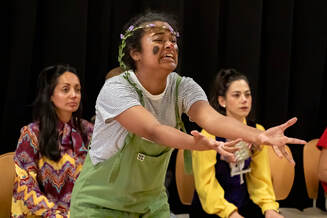
Concision helps in making a Hamlet adaptation that is dynamic.
Ophelia: Sweet Hamlet.
Hamlet: You’re a whore!
Ophelia: reacts I’m a virgin!
Hamlet: You’re spying for THEM!
You wear too much makeup!
Nunnery!
Ophelia sobs. Post hashtag Ophelia runs in and hugs her.
PHTO: Toxic masculinity! To Hamlet: You’re toxic!
Clown chorus: With a taste of your lips, I'm on a ride
You're toxic, I'm slippin' under …
Incorporating skills and playing fast and loose with the text (yay, no living author, no copyright!)
As part of the preparation for devising, I gather a list of the group’s individual skills. One cast member could tap dance. We took lines from Polonius’s parting words to Laertes and used them to show his inadequate support of his daughter, Ophelia.
Ophelia: Daddy, something awful just happened. I need your advice!
Polonius: Of course! Act 1 Acene 3 – my big advice number!
He delivers the text with grace notes of tap dance. At one point, he finds himself inside the outline of the old King and worriedly steps out of it, flourishes and cartwheels off.
Other highlights include Clown elements of anachronism and moments of bathos.
The Therapist waxes lyrical about the delights of Denmark including the beer, the weed in Christiania and the statue of the Little Mermaid.
In the scene of the war with Norway, clowns are dotted about the stage engaged in inept hand to hand struggle (grunting) and lame sword fighting (ineffectual tap tap tap tapping).
The Therapist is driven mad by Hamlet’s constant prevaricating and lack of commitment and in a moment of high emotion, turns to the side of the performance space, pulls forward the seated Horatio’s hand and deliberately falls on the innocent, appalled Horatio’s tiny sword.
Documentary Presenter Clown: So much suffering.
The game of a scene
In the scene of Hamlet’s failed attempt to dispatch the praying Claudius, murderous intent is embodied by tiptoeing clowns (including, illogically, but poignantly, the Ghost King) wielding an arsenal of swords, axes and a plastic chainsaw. When Claudius spots them on their third Grandmother’s Footsteps attempt, they form into a crucifix statue (weapons radiating out like a halo from Christ’s head) and Claudius lamely leaves, apologising: ‘Sorry, Jesus.’
Rosencrantz and Guildenstern, the hapless friend/spies, enter with early Beatles-movie slapstick movements while the Benny Hill theme tune played on kazoos. Their text is a mix of Shakespeare and Stoppard.
Ros: You'd wake up dead for a start and then where would you be?
Dead in a box.
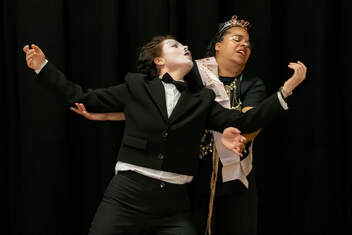
This Chaplin-Polonius pedantically mimes to an eye-rolling Gertrude that he will hide (which he does in full sight, in chameleon mode, in front of the black back drape). Hamlet and his mother have a rap battle and the subsequent stabbing generates a prolonged slapstick death scene.
(In our Clown Adaptation, the clowns are ’all hands on deck’ to step in to play any character needed in the moment. In clown logic, multiples are possible and in big casts, desirable).
Horatio is frequently accompanying Hamlet – a spare wheel, a helpless witness and a metaphor for unemployed valiant action. Although he’s not an official Dramatis Personnae in the text Act 3 Scene 4, the horrified Horatio is present to help drag the Chaplin/Polonius off.
Amplifying the main Metaphor - Intervening the Intervention
The Post Hashtag Ophelia clown contributed the idea for a scene of multiple Ophelia’s, all seeing no hope and repeatedly killing themselves in various mimed ways (drowning, gas oven, pistol etc) while the ‘Post-Hashtag-MeToo’ PHT Ophelia tries desperately, attending to them all like so many spinning plates, to break the tragic pattern.
PHT Ophelia: I intervene! I am Ophelia.
The clowns are all seated on either side see an opportunity for a Spartacus moment.
Random Clown 1: I am Ophelia.
Random Clown 2: I am Ophelia.
Random Clown 3: I am Ophelia.
Random Clown 4: I am Ophelia.
Random Clown 5: I am Ophelia.
Horatio: holding high his tiny sword I’m Horatio!
PHTO: I am post-hashtag Ophelia. I smash the instruments of my imprisonment. I stand up for my rights. I defy my role as obedient daughter. I break free from the Lego-locked role of obedient daughter.*
Multiple Ophelia 1: I am Ophelia. I drown in my own tears. Cries and mimes water rising water and drowning.
PHTO: What? No! Don’t drown yourself!
Multiple Ophelia 2: I am Ophelia – I put my head in the not-yet-invented gas oven. Mimes it and slumps to floor
PHTO: no!
Multiple Ophelia 3: I am Ophelia cuts wrist and mimes fountaining blood.
PHTO: No. Don’t do that!
Multiple Ophelia 4: I am Ophelia noose to neck, suspended, twisting.
PHTO: No don’t hang yourself. Snip! snips the mime rope and MO 4 falls Sorry.
Multiple Ophelia 5: I am Ophelia mimes gun to head
PHTO: Give me that! to MO 1: Stop it! Learn to swim! to MO 2: Make a cake or something!
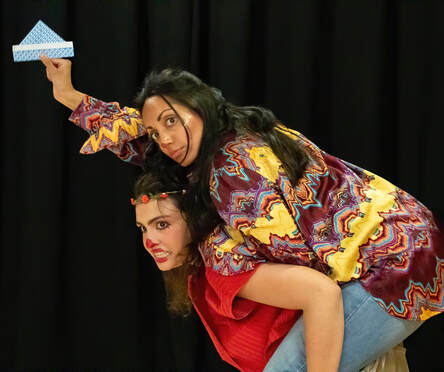
A change of scale
Transitions help concision and aid absurdity. And changing the scale and stage location of the action creates texture and depth. The Ophelias mime drowning in the rising tide of their own tears and swirl out to the chairs at the sides. Having established a body of water, a small folded boat appears. One clown begins to carry another on her back slowly across the stage.
Sea Voyage Clown: Hamlet boards a boat to the UK. At first the weather was good and the sea calm. Then there was a storm (mime) lightning (mime) and rain (mime and boat rocks).
A whale (mime) spurt! Her face tilts either side of the paper boat’s tiny sails.
In a small voice: To be or not to be. Letters! The old switcheroo! ... Look, the white cliffs of Dover!
Boat moves, screeches to a halt like a car.
The King of England.
The Clown who plays Rosencrantz now sports a MacDonalds Happy Meal crown. He takes the boat, unfolds it and reads the letter.
King of UK: It shall be done.
Refolds and hands back. Sits.
Sea Voyage Clown: Goodbye Ros and Guil!
Ros and Gul Pop up and down like pistons on the mention of their own names, saying:
Ros: Dead
Guil: In a box.
Weaving the metaphors together, serving the ensemble
There’s another intervention letter, this time read to Hamlet by Yorick. A couple of scenes later, when Laertes enters the Classic Play plot, the promise of violence rises. The clowns who, by nature, love play opportunities and picking up on the passionate voice of The Poison are enthusiastic about the idea of Revenge. Tensions arise between the majority and the original Intervention clown. The Documentary Presenter Clown pays lip service to ‘healing’ while callously standing in the middle of the crime scene body outline. ‘Oops.’
There was an ensemble member who had suggested that his clown could always be delivering lines from the wrong play. This was his moment, helping to accelerate and add chaos. It's a bit of silliness, but his text mistakes also echo the main characters' mistakes in judgement.
Wrong Play Clown: Elizabeth Kubler-Ross: the stages of grief: shock, denial, anger ..
Ghost King: Vengeance!
Wrong Play Clown: Vengeance!
Documentary Clown: Action! … clap
Intervention clown: Nooooooooooo.
Wrong Play Clown: Blow winds … Clown Chorus: Wrong play!
What light through yonder … Clown Chorus: Wrong play!
Hey nonny nonny … Clown Chorus: Wrong play!
Wrong Play Clown is nonplussed.
Claudius (swiftly at his shoulder): Kill Hamlet.
A number of clowns in the spirit of ‘Yes, lets!’ shout in unison: KILL HAMLET!!
Wrong Play Clown: A sword, a sword my kingdom for a sword! **
Several assorted weapons (from the Claudius praying scene) come in.
Various Clowns: Here, here, here, here, here!
Clown with Final sword: For your consideration!
Intervention Clown appearing through Wrong Play Clown’s legs: No no no! It doesn’t have to end this way.
All weapon bearing clowns: It’s a play - it has to end!
We see a quick setting up of the sword fight. The Poison rubs herself on the weapons, and Hamlet and Laertes tap tap tap lamely at the back. We see Gertrude killed by poison. Hamlet kills Claudius.
Wrong Play Clown: Try again, fail again, fail better. Clown Chorus: Wrong play!!
Documentary Clown: … and cut!
All clowns surge forward saying: Cut! Cut! Cut! Cut! Cut! as they, with weapons, attack Claudius and each other in slo-mo.
Documentary Presenter Clown: rising up from the pile of bodies It’s a wrap, everybody!
Curtain call as the Black Eyed Peas play, with the track starting at one minute in.
People killin', people dyin'
Children hurt, hear them cryin'
Can you practice what you preach
Or would you turn the other cheek?
Father, Father, Father, help us
Send some guidance from above
'Cause people got me, got me questionin'
Where is the love (love)
Where is the love? (The love)
Where is the love? (The love)
Where is the love? (The love)
Where is the love? (The love)
Where is the love? (The love)
Where is the love? (The love)
Where is the love, the love, the love?
END
Phew, that was a little long but then Hamlet is long – although our adaptation was a tight hour.
* Her text was inspired by Hamlet Machine, then edited back severely to serve the comic principle of Concision. Lego is mentioned because, hey, as well as being home to Hamlet, Denmark is also home to Lego.
** The chorused 'Wrong play!' omitted here so as to serve the immediacy of the rhythm of the five swords arriving - 1,2,3,4,5.
EXTRA NOTE:
A. I leaned on Hamlet in my 2002 show, Midriff. An excerpt:
“Will she say: Lately, I’ve been thinking about death. holding skull
Or will she say: Do you think I have good bone structure?
Isn’t this a great prop? look at skull
Alas poor Yorick, I knew him well ... a fellow of infinite jest.
Lately I have been thinking about death.
And Hamlet ... I’m almost obsessed with it -
Shakespeare’s story of Hamlet …
Possibly the acme of British literature -
And it’s all about clumsiness and cowardice.
A noble tragedy with some very good black jokes.
It’s about someone who goes around acting like a trip idiot
while he tries to do the right thing
or cod actorly pose talks about doing the right thing.
It’s about the ability of actors to look at skull move their audience
And the uselessness of emotion
It’s about conscience and the courage of one’s convictions,
hesitation, procrastination, renunciation,
divided loyalty,
guilt and grief.
It’s a great big feat of language
which describes the failure of
words
words, words.”
B. The production described is Clown, but I discovered this quote is about Commedia dell’Arte. I find it relevant to ‘Fixing Hamlet’.
'The irony is that humans are a disaster, but we can do nothing about it, but there is a need at the end to
forgive humanity ... Commedia is tragedy without catharsis. Somehow to me Commedia is far more tragic than tragedy. In Classical Tragedy at the end you have … the catharsis, you get purified… somehow you get de‐responsibilised … all your sins are taken away … with tragedy at the end you are purified, somehow, somehow … but for me it is far more tragic admitting that humans are a disaster.'
(Iurressevitch, Appendix A, 2015: 91) – from Olly Crick’s PhD Thesis.
All images (except for the rehearsal snap) by Linda Carter.

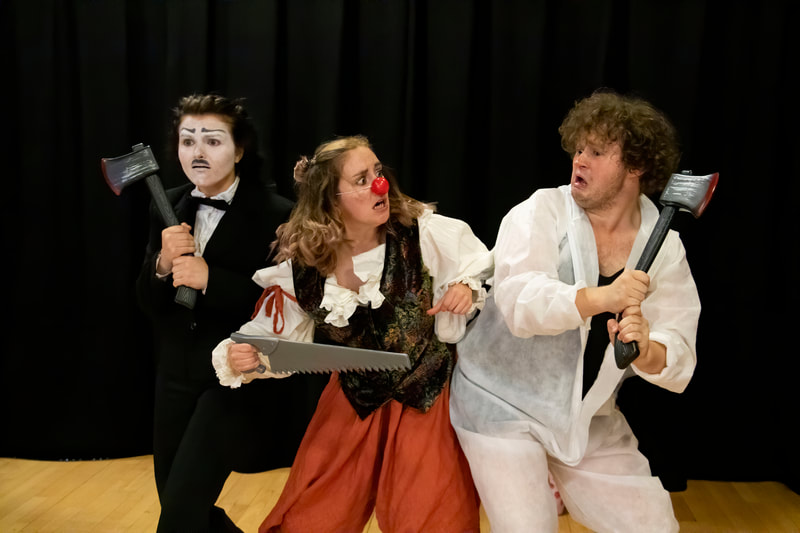
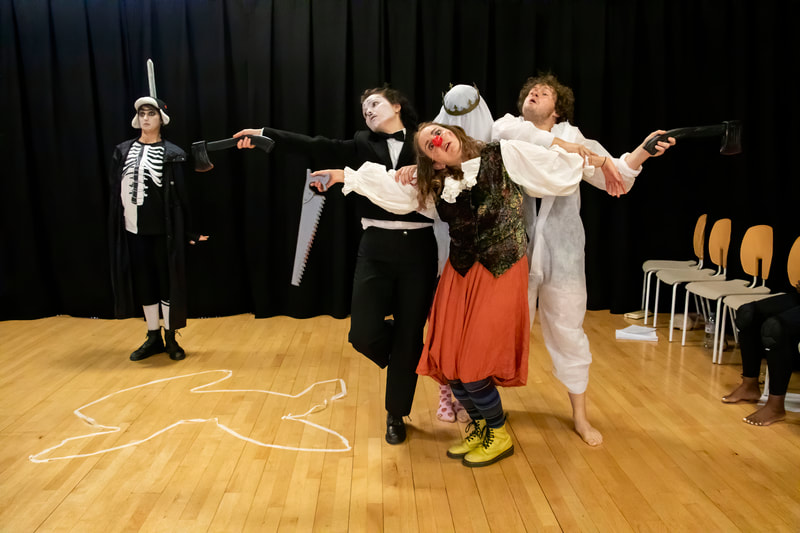
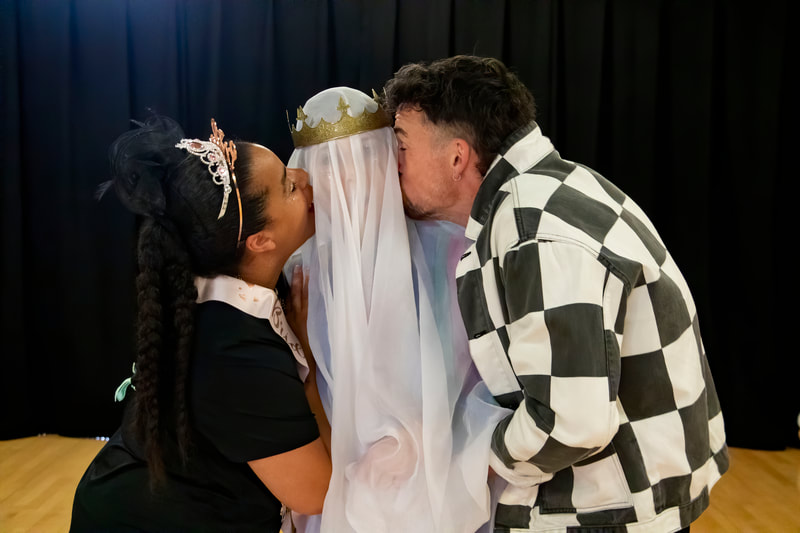
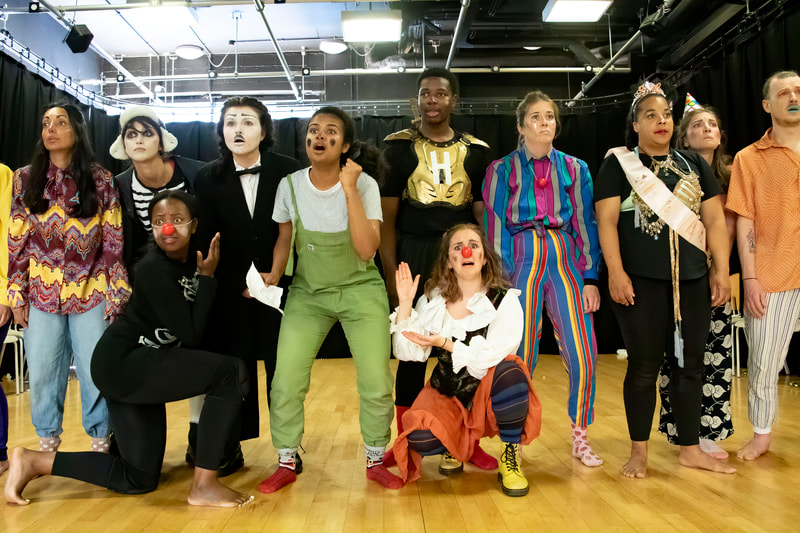
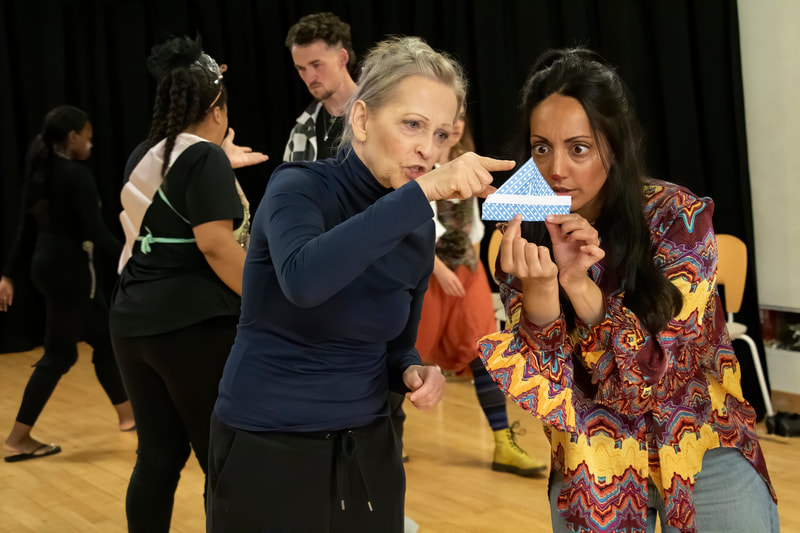
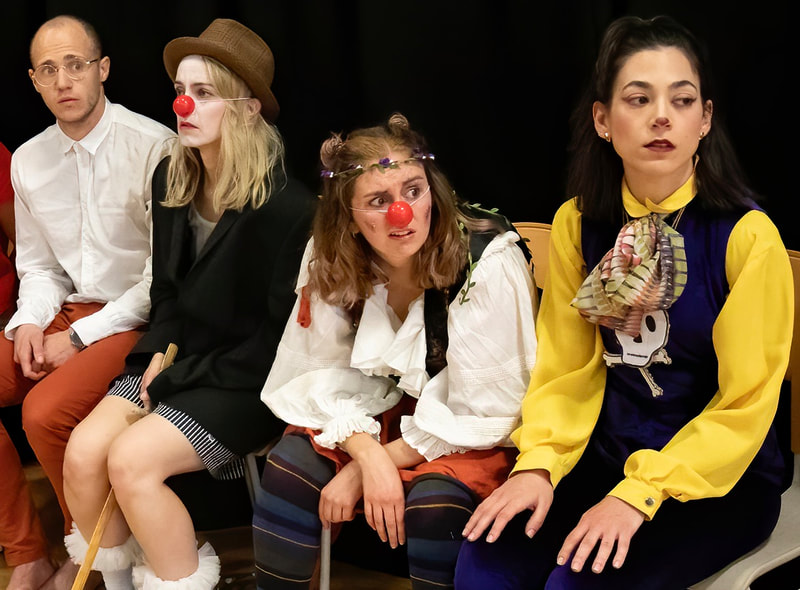
 RSS Feed
RSS Feed
